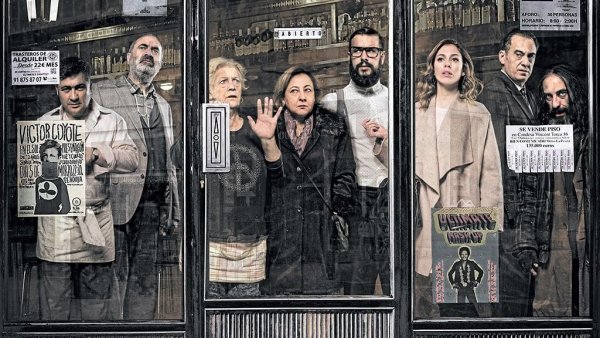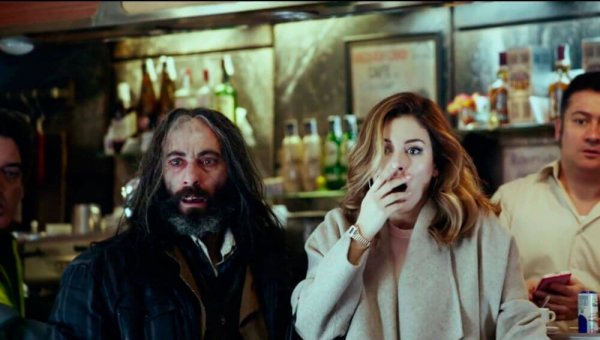The Bar: The Absurdity of Human Nature

The last two films by Bilbao filmmaker Álex de la Iglesia premiered right around the same time. The Bar and Perfect Strangers premiered in 2017, although they had a very different impact. While the former made a modest profit, the latter became the director’s highest-grossing film. Therefore, perhaps the plot of the remake was a lot more attractive to the audience than The Bar, which is a lot more peculiar.
The succession of crazy events is fascinating most of the time but also becomes really absurd. Personally, I think that The Bar is an enjoyable, entertaining movie with a rather attractive plot. However, it can be tiresome and is a movie that failed to shine among the filmmaker’s other movies. It’s just more of the same.
Plot
A normal morning, a group of people in Madrid is having breakfast at a bar. Some of the patrons are acquainted with each other, while others are just passing through. Suddenly, the routine is interrupted by tragedy: someone is shot and killed outside the bar. The urban chaos vanishes, the city seems deserted, and this group of characters is trapped inside the bar.
The Bar has an interesting plot and presents the characters well, as if they were the reflection of society. De la Iglesia manages to capture the truth behind the mask, the nature that we hide behind the roles we play in society.
The bar: A non-place
The bar that we see in the movie is a bar like any other. There’s nothing special about it. It’s the local bar where people in the surrounding areas eat breakfast every morning. Or people who, like Elena, will never step in again. In that familiar, limited space, the characters make the movie come to life.
Marc Augé is a French anthropologist who’s credited with the term “non-place.” But what exactly is a non-place? It’s a temporary path, a place where identity doesn’t manifest itself. Augé identifies motorways, hotel rooms, airplanes, etc. as non-places. These are places where people stay for a short time, locations where they’ll hardly interact with others, nor build any meaningful relationships.
A non-place is the opposite of an anthropological place, the place where identity resides. Non-places are transitory. They’re spaces that plague contemporary society. Whether or not a certain space is a non-place is subjective. It depends on what that certain place means to a particular individual.

Bar setting
This bar is a non-place in the framework of a city that never stops moving. It’s also a place of anonymity for many, and a shelter to others. In the bar, we meet Elena. She’s a young woman who only entered the bar to charge her phone. Then there’s Trini, a customer who comes every day to play the slot machine.
Elena and Trini aren’t the only characters who become trapped in that small space. Eight characters in total become trapped. Álex de la Iglesia has shown his knack for claustrophobia in previous films. He often traps people in places where they’ll face extreme situations. For example, Common Wealth or My Big Night.
The ensemble cast as a sample of society
The Bar is a good representation of modern Spain. The eight characters are diverse: there’s a homeless person, a young, but extremely insecure young woman, a middle-aged, normal-looking woman with gambling problems, a young hipster, an ex-policeman who was fired from the police force due to alcoholism, among others.
As the situation becomes more desperate, the characters show their true colors. The Spanish philosopher Eugenio Trías spoke about these issues in his work Philosophy and Carnival. For Trías, we act according to conventions, to the roles that society itself has imposed on us. But we have multiple roles and don’t act the same in all situations. We don’t project the same image all the time.
This is precisely what we appreciate the most about the film. For example, we see that Elena doesn’t act the same when she talks to her friend on the phone as she does when she enters the bar. Likewise, all the characters have a certain duality: the image they project and the secrets they hide from others.

The masks come off
This masked dance is a reflection of our world, of the bars that we frequent daily, and also of the modern cities where personalities multiply fast. Interestingly, the character whose identity remains most stable at all times is Israel, the homeless man. Above all, Israel seems not to belong to the same world as the rest of them. He’s a man who has experienced many problems, and yet never tries to deceive us.
As the situation becomes desperate, all the characters struggle for their individual survival. In the middle of this, the philosophy of “every man for himself,” prevails, and the masks come off. This reflects the hypocrisy that surrounds our world. However, Israel doesn’t take off a mask or, at least, he does it to a lesser extent. Why? Simply because Israel doesn’t strive to please anyone. He never tries to project a different image of who he is.
Conclusion
Are those we exclude the most authentic among us? Israel is already in a desperate situation, already fighting every day for his survival. For that reason, he’s a pariah in society and, as a consequence, doesn’t wear a mask. Between the eschatological, the comic, and the tragic, The Bar makes us see human beings at their rawest. The Bar poses a situation in which survival prevails over morality and social norms. When the characters take their masks off, we see their worst facets.
“Subdue your appetites, my dears, and you’ve conquered human nature.”
-Charles Dickens-
The last two films by Bilbao filmmaker Álex de la Iglesia premiered right around the same time. The Bar and Perfect Strangers premiered in 2017, although they had a very different impact. While the former made a modest profit, the latter became the director’s highest-grossing film. Therefore, perhaps the plot of the remake was a lot more attractive to the audience than The Bar, which is a lot more peculiar.
The succession of crazy events is fascinating most of the time but also becomes really absurd. Personally, I think that The Bar is an enjoyable, entertaining movie with a rather attractive plot. However, it can be tiresome and is a movie that failed to shine among the filmmaker’s other movies. It’s just more of the same.
Plot
A normal morning, a group of people in Madrid is having breakfast at a bar. Some of the patrons are acquainted with each other, while others are just passing through. Suddenly, the routine is interrupted by tragedy: someone is shot and killed outside the bar. The urban chaos vanishes, the city seems deserted, and this group of characters is trapped inside the bar.
The Bar has an interesting plot and presents the characters well, as if they were the reflection of society. De la Iglesia manages to capture the truth behind the mask, the nature that we hide behind the roles we play in society.
The bar: A non-place
The bar that we see in the movie is a bar like any other. There’s nothing special about it. It’s the local bar where people in the surrounding areas eat breakfast every morning. Or people who, like Elena, will never step in again. In that familiar, limited space, the characters make the movie come to life.
Marc Augé is a French anthropologist who’s credited with the term “non-place.” But what exactly is a non-place? It’s a temporary path, a place where identity doesn’t manifest itself. Augé identifies motorways, hotel rooms, airplanes, etc. as non-places. These are places where people stay for a short time, locations where they’ll hardly interact with others, nor build any meaningful relationships.
A non-place is the opposite of an anthropological place, the place where identity resides. Non-places are transitory. They’re spaces that plague contemporary society. Whether or not a certain space is a non-place is subjective. It depends on what that certain place means to a particular individual.

Bar setting
This bar is a non-place in the framework of a city that never stops moving. It’s also a place of anonymity for many, and a shelter to others. In the bar, we meet Elena. She’s a young woman who only entered the bar to charge her phone. Then there’s Trini, a customer who comes every day to play the slot machine.
Elena and Trini aren’t the only characters who become trapped in that small space. Eight characters in total become trapped. Álex de la Iglesia has shown his knack for claustrophobia in previous films. He often traps people in places where they’ll face extreme situations. For example, Common Wealth or My Big Night.
The ensemble cast as a sample of society
The Bar is a good representation of modern Spain. The eight characters are diverse: there’s a homeless person, a young, but extremely insecure young woman, a middle-aged, normal-looking woman with gambling problems, a young hipster, an ex-policeman who was fired from the police force due to alcoholism, among others.
As the situation becomes more desperate, the characters show their true colors. The Spanish philosopher Eugenio Trías spoke about these issues in his work Philosophy and Carnival. For Trías, we act according to conventions, to the roles that society itself has imposed on us. But we have multiple roles and don’t act the same in all situations. We don’t project the same image all the time.
This is precisely what we appreciate the most about the film. For example, we see that Elena doesn’t act the same when she talks to her friend on the phone as she does when she enters the bar. Likewise, all the characters have a certain duality: the image they project and the secrets they hide from others.

The masks come off
This masked dance is a reflection of our world, of the bars that we frequent daily, and also of the modern cities where personalities multiply fast. Interestingly, the character whose identity remains most stable at all times is Israel, the homeless man. Above all, Israel seems not to belong to the same world as the rest of them. He’s a man who has experienced many problems, and yet never tries to deceive us.
As the situation becomes desperate, all the characters struggle for their individual survival. In the middle of this, the philosophy of “every man for himself,” prevails, and the masks come off. This reflects the hypocrisy that surrounds our world. However, Israel doesn’t take off a mask or, at least, he does it to a lesser extent. Why? Simply because Israel doesn’t strive to please anyone. He never tries to project a different image of who he is.
Conclusion
Are those we exclude the most authentic among us? Israel is already in a desperate situation, already fighting every day for his survival. For that reason, he’s a pariah in society and, as a consequence, doesn’t wear a mask. Between the eschatological, the comic, and the tragic, The Bar makes us see human beings at their rawest. The Bar poses a situation in which survival prevails over morality and social norms. When the characters take their masks off, we see their worst facets.
“Subdue your appetites, my dears, and you’ve conquered human nature.”
-Charles Dickens-
All cited sources were thoroughly reviewed by our team to ensure their quality, reliability, currency, and validity. The bibliography of this article was considered reliable and of academic or scientific accuracy.
- Augé, M., (2009): Los no lugares: espacios del anonimato. Antropología sobre modernidad. Barcelona, Gedisa.
- Trías, E. (1984): Filosofía y Carnaval y otros textos afines. Barcelona, Anagrama.
This text is provided for informational purposes only and does not replace consultation with a professional. If in doubt, consult your specialist.







